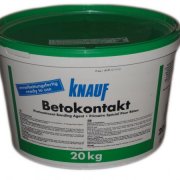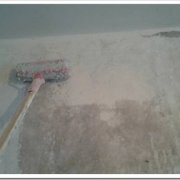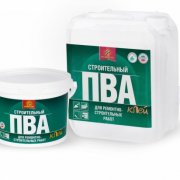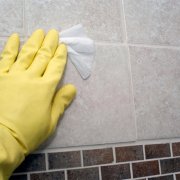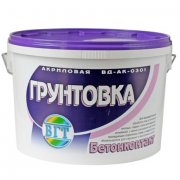GOST primer (part 2)
Primer is the preparation of the surface for further finishing, as well as the protection of the building base from moisture, aggressive bacterial environment, etc. The use of a primer does not cause problems, even if you apply it with your own hands, without turning to professionals for help. The main thing is to choose a high-quality primer that is suitable for the treated surface.
The content of the article
Primer Description
Primer is an emulsion product used in construction. Such a product improves the adhesion of the finishing material to the surface. The primer also aligns the substrate and fills the defects. The composition is applied by brush, roller or spray, as shown in the photo.
Primers contain bitumen, drying oil, resin, oil and glue. These substances form a film on the surface after application of the product, accelerate drying and determine the properties of the primer. The primer in the composition may also have solvents. You can recognize such compounds by a sharp unpleasant odor. Their use is carried out in a ventilated room.
How to choose a primer?
GOST is a kind of quality mark of goods. He says that the products meet the standards set by the state. Therefore, buyers try to choose goods only marked GOST. The primer was no exception. If there is such a marking, the primer is bought much more readily than without it. However, one should also look at the signs next to GOST. They will tell you what material the primer is suitable for.
Composition Criteria
Types of primer by type of base:
- Acrylic primer. Suitable for all types of surfaces. The primer dries in 4 hours, dissolves in water, does not exude unpleasant odors and is safe for health.
- Alkyd compound. It is recommended for use for metal and wooden building foundations. Such a primer does not exude unpleasant odors. Drying time - 15 hours.
- Glifthal primer. It is used only indoors for metal building foundations. The drying period is 24 hours.
- Phenolic agent. Used for wood and metal surfaces. Dries in 12 hours.
- Perchlorovinyl primer. It is applied to concrete, plastered and metal surfaces. The primer is recommended for use outdoors. Drying time - 60 minutes at a temperature of 200 WITH.
- Polystyrene composition. It is used for plastered and wooden substrates. It can not be used indoors due to the content of solvents that can provoke poisoning of the body.
- Polyvinyl acetate primer. It is applied only under the paint of the same name. Drying time is 30 minutes.
Intended selection criteria
Types of primer for the intended purpose:
- Impregnation primer. Recommended for strengthening brittle plaster. Such a primer is applied to drywall before tiling or wallpapering. The composition does not only strengthen the surface, but also protects it from moisture.
- Antiseptic primer. The main purpose is to protect the surface from mold and fungus. The composition also improves the adhesion of the surface and the finish.
- Corrosion resistant primer. It is recommended for use on a metal surface, as it protects it from rust.
Selection criteria by surface type
For metal
For the metal base, 4 types of primers are suitable:
- insulating;
- passivating;
- tread;
- phosphating.
The number of isolating primers includes GOST GF 021 primer.Such a composition is suitable for processing metal as well as wooden surfaces. Primer is used for oil and nitro paints. GOST for the primer GF 021 was introduced on 01/01/1983 and is valid now. The primer contains solvents, which indicates flammability. The content of these substances also explains the sharp stock of the composition.
The isolating compositions also include the primer HS-04 GOST and GOST 9355 81 - the primer HS-010.
Passivating agents include GOST primers AK-070, GF-031 and others. These compounds are recommended for use with stainless steel and alloys. Primers contain pigments that have the property of passivating the metal.
Tread primers contain metal powder. Due to this, the primer creates a dense impermeable film on the surface.
Phosphating primers are recommended for non-ferrous and ferrous metals. Means improve adhesion of the paint to the base. These include primers VL-023, VL-03, etc.
For wood
The following primer types are suitable for this surface:
- acrylic primers. These primers have the best combination of price and quality. The compositions are easy to apply and dry quickly. Acrylic primer GOST 25129 GF-021 is suitable for wood. It is also applicable to metal, as mentioned above. A water-dispersion primer GOST 52020-2003 is also suitable for wood;
- alkyd primers. The products are recommended for use on wood that has not been processed. After priming, an even film is formed on the surface that hides roughness. Alkyd compositions include primer PF-020 GOST 18186-72;
- polyurethane and epoxy primers. These products contain solvents, so primers should be used with caution.
For other surfaces
For concrete and brick surfaces, a deep penetration primer is recommended. It fills microcracks, binds residues of dust and dirt and improves adhesion between the base and the material. GOST for deep penetration primer - R ISO 9001-2001.
One of the best compositions for concrete is the GOST 28196 concrete contact primer. It has a unique composition. Russian primers contain marble flour, and foreign manufacturers add quartz sand to the primer. Such additives improve adhesion between concrete and decorating material. Concrete contact is also recommended for use on surfaces such as glass, tile, etc.
Silicone primers are recommended for use on all types of surfaces. If a primer of this type is used for brick and stone substrates, then it performs not only the functions of a bonding layer, but also a hydrophobic coating.
Primer application
Any kind of primer, for whatever surface it is used, is applied to the substrate before finishing. The primer is used before wallpapering, laying tiles, painting, plastering, etc. It strengthens both the base and the finish.
When the instructions for the use of the primer are carefully studied, there are no problems with the use and the final result.
The treated surface is freed from old materials and thoroughly cleaned of dust or contaminants. If liquids were used in the process, wait until the base has dried before priming.
The finished primer is thoroughly mixed, and the concentrate is diluted with water. Proportions - 1: 1. Then the tool is taken, and the surface is treated with a primer in one layer. To apply the composition, as already mentioned, brushes, rollers and spray are used. After applying the first coat, wait until it dries. Only then can a second coat be applied. When the work is completed, you can not immediately proceed to the finish. It is necessary to wait until the primer dries. Only then is the topcoat applied.
On the video clearly demonstrated how to apply a primer.
When purchasing a primer, it is necessary to take into account its GOST. It will help you choose the right primer suitable for the surface that needs to be treated.

